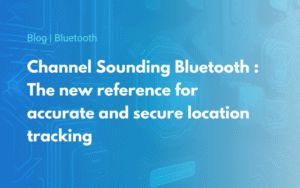A Bluetooth beacon is a small, connected beacon using Bluetooth Low Energy (BLE ) technology to transmit small amounts of data at close range. These beacons are widely used in industrial, logistics and commercial environments for a variety of purposes:
- Transport and telematics (temperature monitoring, door opening detection, etc.)
- Industry 4.0 (geolocation of logistics equipment, etc.)
- Smart building (tool geolocation, people access control, etc.)
- Healthcare (temperature monitoring of pharmaceutical products, geolocation of medical equipment, etc.)
- Smart agriculture (animal monitoring, herd health management, farm equipment monitoring, etc.)
The global market for Bluetooth Beacons and iBeacon is booming: estimated at 2.19 billion USD in 2024, it is set to reach 21.07 billion USD by 2034, with average annual growth of over 25%(source: Global Growth Insights).
Unlike consumer Bluetooth devices (such as speakers or headsets), beacons don’t transmit media, but rather identifiers or useful information that serve as the basis for business applications in the IoT and traceability fields.
How does a beacon work?
The architecture of a system based on Bluetooth beacons is simple but effective:
Beacon → BLE Gateway → Back-end → Business application.
Operating steps
- The beacon regularly emits a signal containing a unique identifier and basic information.
- The Bluetooth Low Energy gateway detects nearby signals and centralizes the data collected.
- The back-end interprets the information, associating it with equipment, zones or events according to business logic.
- The business application displays results, triggers alerts or updates IoT dashboards in real time.
Why configuration is crucial for integrators
In industrial or logistics environments, incorrect configuration can lead to loss of performance, excessive battery consumption or radio saturation.
- Reduced range or autonomy due to incorrect settings.
- Need to standardize identifiers (UUID / major / minor) for large beacon fleets.
- Direct influence of radio parameters on data reliability.
- Transmission interval too short → battery consumed too quickly.
- Interval too long → notifications or inventories delayed.
- Poorly adjusted power → dead zones or interference.
Tools for configuring your beacons – ELA Innovation
ELA Innovation provides the Device Manager Suite, a complete software suite for configuring and deploying :
- Device Manager PC: full configuration of BLE beacons and other technologies.
- Device Manager Activator: single or serial activation or deactivation.
- Device Manager Connector: scan and connect Bluetooth beacons.
These tools enable you to quickly prepare, test and deploy your beacons. To test, go to Device Manager Suite.
Practical configuration steps
1. Identification and nomenclature
- Scan tags via Device Manager.
- Prepare your NFC reader and BOM.
2. Radio settings
- Choose protocol: iBeacon for iOS, Eddystone for Android or ELA Custom.
- Adjust power and interval according to use: 500 ms for access control, 5 s for inventory.
3. Activate advanced functions
- 3-axis accelerometer: transmission frequency modulated according to movement.
- Push-button (Blue LITE TOUCH): sends manual actions.
- LED / buzzer (Blue PUCK BUZZ): rapid physical localization.
4. Field validation
- Check detection via a BLE gateway.
- Control data integration in the back-end.
- Adjust parameters according to field tests.
Need help with your project?

Case studies (examples)
- Automatic inventory – Blue COIN ID: interval 5 s, power 0 dBm.
- Machine tracking – Blue PUCK ID: interval 2 s, power +4 dBm, accelerometer activated.
- Access control – Blue LITE TOUCH: 500 ms interval, push-button activated.
Best practices for integrators
- Standardize configuration profiles according to use case.
- Document settings to facilitate maintenance and future expansion.
- Adjust power and interval to avoid radio saturation or dead zones.
Conclusion
Setting up an industrial Bluetooth beacon is an essential step in guaranteeing reliability, accuracy and autonomy. By following these best practices, you can optimize the performance of your Bluetooth Low Energy installations.
With the ELA Innovation range of Bluetooth beacons, you have all the tools you need to integrate your beacons efficiently into your IoT solutions.

Also read: What is Bluetooth Low Energy?



